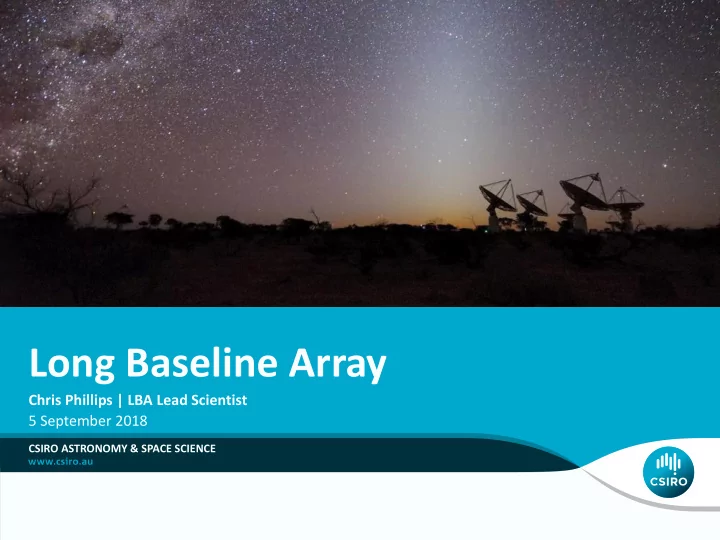

Long Baseline Array Chris Phillips | LBA Lead Scientist 5 September 2018 CSIRO ASTRONOMY & SPACE SCIENCE
The Long Baseline Array (LBA) Operated as a National Facility by CSIRO Astronomy & Space Science, in close cooperation with the University of Tasmania, Hartebeesthoek Radio Observatory and Auckland University of Technology Core elements: ATCA (5x22m), Mopra (22m), Parkes (64m), Ceduna (30m), Hobart (26m) + Tidbinbilla (70m & 34m), Warkworth (12m & 30m), Hartebeesthoek (26m & 15m), ASKAP (12m), AuScope (3x12m), plus ad-hoc arrangements with Korea and China. Typically ~25 days observing each year in ~4 sessions Plus RadioAstron survey and imaging experiments, some EVN/global experiments
EAVW 2018 | LBA | Phillips
Baseline lengths in km Pa At Mp Ho Cd Hh Yg Ke Ak Ww Ti Pa 0 322 207 1089 1361 9665 3128 2610 3091 2425 274 At 322 0 114 1396 1508 9847 3266 2493 3202 2409 566 Mp 207 114 0 1286 1448 9783 3213 2530 3159 2411 458 Ho 1089 1396 1286 0 1702 9167 3211 3431 3273 2415 832 Cd 1361 1508 1448 1702 0 8944 1792 1937 1756 3718 1455 Hh 9665 9847 9783 9167 8944 0 7848 9504 8019 10480 9589 Yg 3128 3266 3213 3211 1792 7848 0 2360 290 5362 3196 Ke 2610 2493 2530 3431 1937 9504 2360 0 2102 4752 2849 Ak 3091 3202 3159 3273 1756 8019 290 2102 0 5360 3184 Ww 2425 2409 2411 2415 3718 10480 5362 4752 5360 0 2301 Ti 274 566 458 832 1455 9589 3196 2849 3184 2301 0
The Long Baseline Array (LBA) • Regular observations in 20, 13, 6, 3, 1cm bands – 1.4-25 GHz – Not all telescopes support all bands ATCA, Mopra 7 & 3mm, Tid 7mm Disk-based recorders (with most data later streamed to the correlator), eVLBI available on subset of the array LBADR, Mk5b and flexbuf recorders Max bit-rate 1Gbps Data correlated on DiFX software correlator at Pawsey supercomputing facility – Deller et al. 2007, PASP, 119, 318 (DiFX) – Deller et al. 2011, PASP, 123, 275 (DiFX-2)
Locations & SEFDs (in Jy) of LBA elements Lat. Long. 20cm 13cm 6cm 3cm 1.5cm 9mm ATCA 5x22m 150 E 30 S 40 40 36 39 106 180 ASKAP 1x12m 117 E 26 S 6000 -- -- 3500 -- -- Ceduna 30m 134 E 32 S 1500 400 450 600 2500 -- Hobart 26m 147 E 43 S 450 650 650 560 1800 -- Hart 26m 28 E 26 S 200 210 290 340 1320 -- Mopra 22m 149 E 31 S 340 530 350 430 675 900 Parkes 64m 148 E 33 S 40 30 110 43 810 -- Tid 70m 149 E 35 S 23 16 -- 25 60 -- Tid 34m 149 E 35 S -- 165 -- 90 -- 180 Warkworth 12m 175 E 37 S 7000 3500 -- 3500 -- -- Warkworth 30m 175 E 37 S -- -- 650 1000 -- --
LBA Science in a year • Measuring accurate position, velocity and distance (via parallax) to objects in our own Galaxy – − • Young massive stars, evolved stars, pulsars, gamma ray sources, black holes − − – µ – • Accurately measure the structure and rotation of our own Galaxy − – – F – C proper motion and magnetic field me asurements. − − –c EAVW 2018 | LBA | Phillips o–h −
LBA Science in a year (cont) • Study the jets of Galactic and extra galactic black holes • Study molecular disc around Circinus galaxy using water molecules • Long term monitoring of radio jets from gamma ray loud AGN • Detection of radio emission towards recent gravitational wave EAVW 2018 | LBA | Phillips
LBA Science in a year (cont) • Improve the international radio reference frame (ICRF) • Determine if SMBH candidate is binary source • Detect radio emission from 90 Jupiter mass brown dwarf star • Systematically compare optical and radio positions of galaxies EAVW 2018 | LBA | Phillips ◦ δ − 16–18 ◦ ◦ ◦ ◦ ◦ − 2528–253 L71–L75. 3775–3787.
Current Developments - ASKAP
Current Developments • Parkes “ Ultrawideband ” receivers • 700-4000 MHz Rx installed May 2018 • 22 K Tsys across band • 4 GHz-26 GHz planned, not funded • Focus cabin digitizers • 12 bit quantization • GPU based backend • Single backend for all modes • Adaptive RFI mitigation • Investigation new calibration • Pseudo random noise, picosecond pulse
Current Status: Pulsar Fold Mode Courtesy of W. van Straten 12 | EAVW 2018 | LBA | Phillips
Current Developments (cont) • Parkes cryo-PAF – funding proposal to be submitted • 36 beam backend – limited by digital backend • 20K Tsys – better than current 13 beam multi-beam • ATCA GPU backend planning • 8 GHz bandwidth • Demonstrated viability at GPUhackathon • ASKAP tied array beam? • PAF VLBI already demonstrated • User Parkes-ASKAP experiment in December
International Collaborations? • Investigating formally joining “global” VLBI experiments • Single proposal requirement • Software correlation and disk base recording make array interoperability much easier • Should be be doing more Asia-LBA observing? • Asian telescopes as part of LBA experiments • LBA antenna as part of EAVN? • Logistics are not trivial: • Data transport (firewalls) • Backend/receiver compatibility • Educate observers on availability
Thank you CASS/ATNF Chris Phillips LBA Lead Scientist t +61 2 9372 4808 E Chris.Phillips@csiro.au w www.atnf.csiro.au CSIRO ASTRONOMY & SPACE SCIENCE
CODIF • CSIRO Oversampled Data Interchange Format • Extension to VDIF • Based on VDIF2 proposal by Alan Whitney • Used with CSIRO PAF at Bonn and Jodrell • Added CODIF support to DIFX • Used with ASKAP “CRAFT” project to localize FRBs
Recommend
More recommend